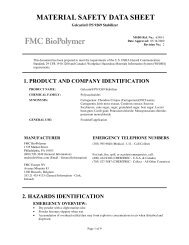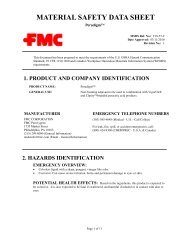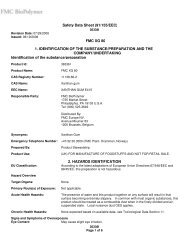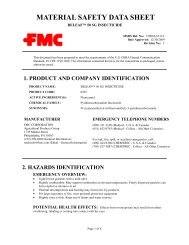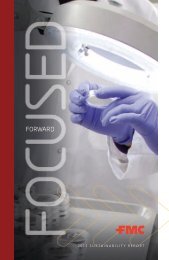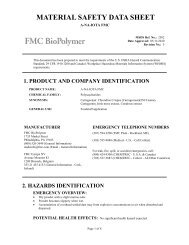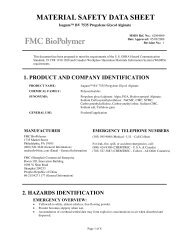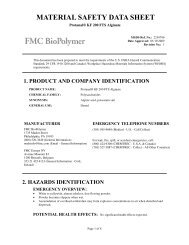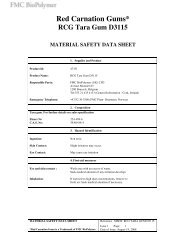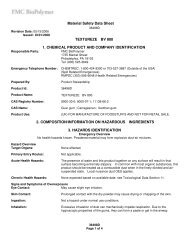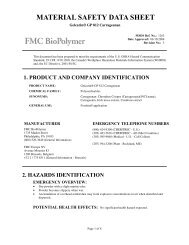Avicel-plus® GP 1610 Stabilizer - FMC Corporation
Avicel-plus® GP 1610 Stabilizer - FMC Corporation
Avicel-plus® GP 1610 Stabilizer - FMC Corporation
You also want an ePaper? Increase the reach of your titles
YUMPU automatically turns print PDFs into web optimized ePapers that Google loves.
<strong>Avicel</strong>-<strong>plus®</strong> <strong>GP</strong> <strong>1610</strong> <strong>Stabilizer</strong> (441C) Date: 12/01/2005<br />
FIRE FIGHTING PROCEDURES: For fires involving this material, do not enter any<br />
enclosed or confined fire space without wearing full protective clothing and self-contained breathing<br />
apparatus (SCBA) approved for firefighting. This is necessary to protect against the hazards of heat,<br />
products of combustion and oxygen deficiency. Do not breathe smoke, gases or vapors generated.<br />
FLAMMABLE LIMITS: Not applicable<br />
6. ACCIDENTAL RELEASE MEASURES<br />
RELEASE NOTES: Powder becomes slippery when wet. Maintain good housekeeping practices<br />
to minimize accumulation of settled dust, especially on overhead surfaces. Sweep up the spilled material<br />
and dispose of in accordance with the waste disposal method outlined in Section 13, "Disposal<br />
Considerations".<br />
7. HANDLING AND STORAGE<br />
HANDLING AND STORAGE: Use local exhaust or general dilution ventilation to control<br />
exposure to dust. Always use safe lifting techniques when manually moving containers, especially when<br />
handling containers weighing more than 50 pounds (22.7 kg). To protect quality, store in a tight container<br />
in a dry place. Avoid exposure to excessive heat.<br />
8. EXPOSURE CONTROLS / PERSONAL PROTECTION<br />
EXPOSURE LIMITS<br />
Chemical Name ACGIH OSHA Supplier<br />
Microcrystalline<br />
cellulose<br />
10 mg/m 3 (TWA)<br />
PERSONAL PROTECTIVE EQUIPMENT<br />
Page 3 of 9<br />
15 mg/m 3 (PEL) (total<br />
dust)<br />
5 mg/m 3 (PEL)<br />
(respirable fraction of<br />
dust)<br />
EYES AND FACE: Whenever airborne dust concentrations are high, appropriate<br />
protective eyewear, such as mono-goggles, should be worn to prevent eye contact.<br />
RESPIRATORY: Whenever dust in the worker's breathing zone cannot be controlled with<br />
ventilation or other engineering means, workers should wear respirators or dust masks approved by<br />
NIOSH/MSHA, EU CEN or comparable certification organization to protect them against airborne<br />
dust.<br />
PROTECTIVE CLOTHING: No special clothing is required.



